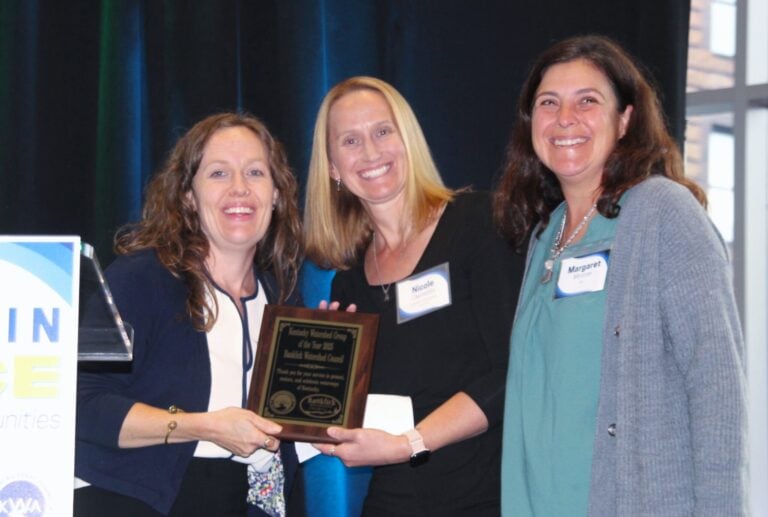By Amy Clancy
Special to NKyTribune
Growth Gap. Something everyone in Kentucky is concerned about. It doesn’t take a scientist to know that student test scores are influenced by so many factors.
Sadly, many of our students identified as at-risk fall into this “growth gap”. At risk students often face family discord and separation, and poverty is a major obstacle.
According to talkpoverty.org’s 2015 Report:
● 25.8% of children under 18 are living below the poverty line in Kentucky.
● We rank 42nd in the nation.
● Seven percent of Kentucky’s children are not living with their parents (ranked 32nd in the nation)
● In 2015, 17% of Kentucky families were food insecure (47th in the nation).

With numbers like this, you can bet that at least one or more of these students will be in your school. If students are suffering at home, they will also suffer in school and learning will be difficult. Recognizing this dilemma, my school, Walton-Verona Independent, initiated a vision: “Schools and Families Empowered.”-
Helping the family helps the school.
The vision began with a grant for this new initiative – a “Safe Agent”- funded by the Department of Juvenile Justice and later the Kentucky Health Department until the Walton-Verona Board of Education elected to continue the position.
Larry Davis was Walton-Verona’s first Safe Agent. He was a man dedicated to making our students feel safe and loved at school.
The function of the Safe Agent reads, “Help to connect students and their families with resources to support, achieve and maintain a wholesome community and educational environment through enhancing all students’ quality of life by assisting them to overcome obstacles and barriers.”
Larry served as Safe Agent from 1999 until 2011 when he passed away. Our school began a fund “Larry’s Kids” to continue supporting our students/families and to honor his name. This fund has enabled our school to provide dental care to students, beds, clothing, food and emotional support most of all, all managed by our current Safe Agent, Nancy Ryan. She meets with students and families with the mission not just to fix things now, but to help families succeed.
She states that due to the Larry’s Kids Fund, “I am able to do more than even a family resource center.”
Small fund raisers such as an annual 5K Walk fund Larry’s Kids, and teachers at Walton-Verona have contributed to the fund for years through payroll deduction; Nancy’s salary is completed funded by the District.
The mission is still alive through Nancy: Help kids. Help families. Strengthen the school. When the family succeeds – the school will succeed.

Nancy has a great advantage in that she lives in the community in which she serves. She was a teacher there for years and is well-respected by all. Nancy Ryan is available. She attends events, connects with kids and observes. High school students know she is available and often pop in or make appointments and the middle and elementary students in our district are often referred by teachers.
Often for the elementary students, Nancy is helping with clothing and she often does home visits.
Nancy says, “The easiest way to describe my job is I’m THE FIXER…I tell the kids that it is my job to fix the grownup problems so they can worry about school. My relationship with students is completely non-judgmental. Because of this they will confide in me and we do our best to face the tough issues with their parents not against them.”
Nancy also networks like crazy with anyone and everyone in the area that can help our kids, including employment for our HS students. She noted Kohls’ generosity and that the fund does pay for the Freestore Foodbank Truck once a year. In the summers she coordinates peanut butter and bread for families in need, coordinates with high school students to provide dresses for prom to those who can’t afford them, and in the past, she coordinated a clothing ‘bank’ for students and families in the area.
So how can districts copy this initiative?
First find someone from the community who understands young people, the influences of the area, as well as the problems struggling families face. While there are no statewide guidelines (Nancy is the only Safe Agent in the state), that person must understand the community to truly understand the students.
“Being from the community is huge, because I have a personal knowledge of so many of their stories and I know their parents.” This person should also be willing to network with the community and surrounding areas,” said Nancy. “I have built relationships with several people in the Northern Kentucky community, to help with food stamps, housing, insurance, even vehicles. This community is amazing in what it is willing to do to help people out. I tell people all the time that I have the best job in America and I do believe that. Just think, I get to help people every day.”
With finances tight, grants are a great opportunity to help fund a Safe Agent Program in your school. But in the meantime, what can schools and teachers do now for their at-risk students? It’s no surprise that teachers must provide students with social-emotional support. Edutopia notes in Social and Emotional Learning Research Review, “Numerous research reports show that social and emotional learning (SEL) can have a positive impact on students’ academic performance” (Vega).

One way we can address SEL needs of children who often face rough circumstances at home, is to model our own thoughts and feelings and to tell our own stories.
When students hear our stories and see how we handled circumstances, we are mentally preparing them – they come to understand that everyone shares problems and we all must work through them. When I share what I went through (to a degree) in my divorce, for example, and I share how it affected my grown children, I let kids know that others have similar experiences.
It isn’t enough to get to know our students; they need to get to know us too. When we share our stories and how we worked through them, we model success. Our students need this model because some don’t see that at home. Kids often return to an empty house or sleep the night alone while a parent works their behind off to make ends meet. Sharing your life – its success and woes – connects us to one another.
The Growth Gap is often a result of many factors – disadvantage, poverty and separation to name a few. One way that Walton-Verona Independent has sought to reduce the gap is through a Safe Agent. If you can’t afford a Safe Agent, sharing your life with your students. You can reach your at-risk kids too. The adult interaction that they have with you could be the only civil interaction they have that day. Ultimately, our at-risk students can succeed if we find ways to help the families succeed.
Amy Clancy is a National Board Re-Certified Teacher of 17 years at Walton-Verona MIddle school- formerly teaching 8th grade Writing and currently serving in a hybrid role teaching yearbook and serving as the ELA Specialist. Amy is a Hope Street Kentucky Teacher Fellow as well as the President and Newsletter Editor for the Kentucky Council of Teachers of English/Language Arts.





















